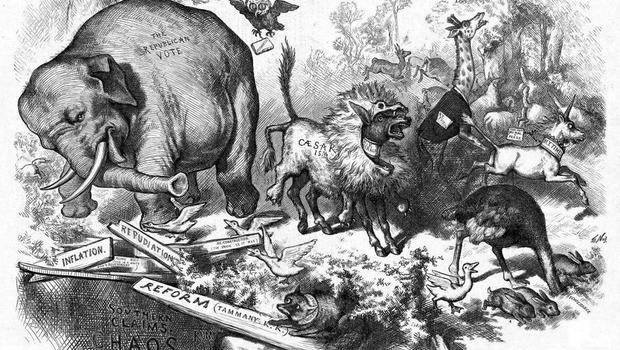Here you have some answers to the questions you asked about the USA political parties and electoral system:
- Here you have the explanation to the symbols of the Democratic and Republican party:

The donkey started being used by the Democrats in the 19th century. During the presidential campaign of that year Democrat candidate Andrew JAckson was called a jackass (a donkey) by his opponents and he decided to adopt this animal for his campaign. Later cartoonist Thomas Nast popularized the symbol.
Thomas Nast was also the inventor of the elephant that became the symbol of the Republican Party. In 1874 he drew a cartoon inwhich the Democrats' donkey appeared as clothed in lion's skin, scaring all the other animals. There was an elephant labelled as "The Republican Vote" and from then on the elephant was associated with the Republican Party.
Here you have Nast's cartoon in Harper's Weekly:

Here you have some more information about this topic:

The donkey started being used by the Democrats in the 19th century. During the presidential campaign of that year Democrat candidate Andrew JAckson was called a jackass (a donkey) by his opponents and he decided to adopt this animal for his campaign. Later cartoonist Thomas Nast popularized the symbol.
Thomas Nast was also the inventor of the elephant that became the symbol of the Republican Party. In 1874 he drew a cartoon inwhich the Democrats' donkey appeared as clothed in lion's skin, scaring all the other animals. There was an elephant labelled as "The Republican Vote" and from then on the elephant was associated with the Republican Party.
Here you have Nast's cartoon in Harper's Weekly:

Democrats today say that the donkey is smart and brave, while Republicans say that the elephant is strong and dignified.
http://www.factmonster.com/ipka/A0881985.html
- The colours associated to every party date back from year 2000 and it comes from the colours the TV channels used to represent the states every party won. . Red is associated to the Republican Party and blue to the Democratic Party. This is the opposite to the use of these colours in Europe, where red colour is associated to leftist parties and blue colour is associated to the conservative- rightist parties. Curiously, before 2000 several channels used red for the Democrats and blue for the Republicans, as we do in Europe.
Here you have two more links about this topic:
http://www.vox.com/2016/9/15/12926618/why-red-means-republican-and-blue-means-democrat
http://www.theverge.com/2012/11/6/3609534/republicans-red-democrats-blue-why-election
- This video explains why they vote on Tuesday. There is a campaign to move the voting day to a holiday, so that more people can vote:http://www.vox.com/2016/9/15/12926618/why-red-means-republican-and-blue-means-democrat
http://www.theverge.com/2012/11/6/3609534/republicans-red-democrats-blue-why-election
- This is a video that explains the process of primary elections, where the USA citizens elect the candidates of each party:
- This video explains all the process to run for the presidential elections:
- Here you have some short videos that explain the peculiar electoral system of the USA, with the importance of the electoral college:

